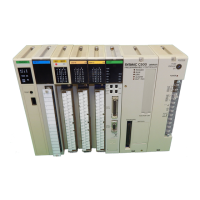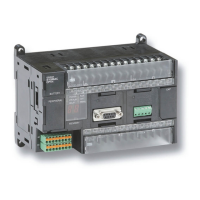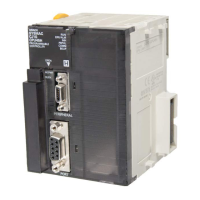Glossary
131
special control lead connected to the EEPROM chip and can be done without
having to remove the EEPROM chip from the device in which it is mounted.
electrical noise Random variations of one or more electrical characteristics, such as voltage,
current, and data, that might interfere with the normal operation of a device.
EM Area Extended Data Memory Area; an area that can be optionally added to certain
PCs to enable greater data storage. Functionally, the EM Area operates like the
DM Area. Area addresses are prefixes with E and only words can be accessed.
The EM Area is separated into multiple banks.
EPROM Erasable programmable read-only memory; a type of ROM in which stored data
can be erased, by ultraviolet light or other means, and reprogrammed.
error code A numeric code generated to indicate that an error exists, and something about
the nature of the error. Some error codes are generated by the system; others
are defined in the program by the operator.
even parity A communication setting that adjusts the number of ON bits so that it is always
even. See parity.
event processing Processing that is performed in response to an event, e.g., an interrupt signal.
Expansion CPU Rack A Rack connected to the CPU Rack to increase the virtual size of the CPU Rack.
Units that may be mounted to the CPU Backplane may also be mounted to the
Expansion CPU Backplane.
Expansion I/O Rack A Rack used to increase the I/O capacity of a PC. In CV-Series PCs, either one
Expansion I/O Rack can be connected directly to the CPU or Expansion CPU
Rack or multiple Expansion I/O Racks can be connected by using an I/O Control
and I/O Interface Units.
FA Factory automation.
factory computer A general-purpose computer, usually quite similar to a business computer, that
is used in automated factory control.
fatal error An error that stops PC operation and requires correction before operation can
continue.
FCS See frame checksum.
FINS See CV-mode.
flag A dedicated bit in memory that is set by the system to indicate some type of oper-
ating status. Some flags, such as the carry flag, can also be set by the operator
or via the program.
force reset The process of forcibly turning OFF a bit via a Programming Device. Bits are
usually turned OFF as a result of program execution.
force set The process of forcibly turning ON a bit via a Programming Device. Bits are usu-
ally turned ON as a result of program execution.
frame checksum The results of exclusive ORing all data within a specified calculation range. The
frame checksum can be calculated on both the sending and receiving end of a
data transfer to confirm that data was transmitted correctly.

